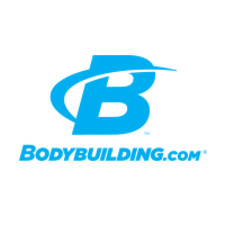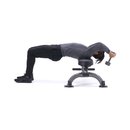I'm what I like to call a "strength runner." That might sound like a contradiction in terms to you, if you're like a lot of people I know. For me it isn't. I love how the body moves, and I love to perform feats of strength. But I'm also in love with running long distances.
As I write this, I am considered one of the largest ultra obstacle course racing (OCR) and ultra-running athletes in the world, at a height of 6-foot-2 and weight of 232 pounds. I used to be a lot bigger, and I owe my transformation in equal parts to distance running and strength training. I feel incredible gratitude for both, and I simply can't choose between "just strength" or "just running." So I have combined the two forms of training and use them in my competitions and everyday life.
I know plenty of people will tell you that it's impossible to run and hold onto that hard-earned muscle mass. Don't believe it! Our bodies can endure long distances if we train and eat appropriately. And our running-only friends can also enhance their running with strength training. In fact, I believe that strength training and endurance running training can enhance any athlete.
Be confident, conditioned, and well-rounded. Be a strength runner!
The Long Journey To Strong
My story starts like a lot of transformations. In the late 1990s, I weighed more than 300 pounds and was severely obese. Once I saw the writing on the wall, I lost more than 100 pounds with mostly cardiovascular activities, including running, and through strict dieting.

{{caption}}
It was only after I lost all that weight that I was introduced to strength training by a friend. She changed my life forever, because when I started strength training, getting stronger was only one part of what happened. I found I was able to eat more, developed an athletic physique, and my overall quality of life improved dramatically.
Bodybuilding has also been a huge part of my strength training programming from the beginning, but not because I wanted to compete onstage. I was only competing with myself and advancing my physique. Along the way, I've also woven in powerlifting, strongman training, and Olympic lifting. Variety, I discovered early on, is the key.
For many people, when they get this serious about strength training, they start to push anything that isn't strength training to the sidelines. They'll take walks, sit on a stationary bike, or ride an elliptical trainer, and treat this "cardio" as a necessary evil. Any more than that, they'll tell you, would cause them to lose muscle and become flabby and weak.
If that's you, so be it. It's not me. As soon as I was introduced to strength training, I began combining it with my endurance running. I couldn't help it; my passion for running has never been something I could just turn off.
Born To Run
I've never—ever—had the build or look of a runner, but I've always loved running. Even years ago, when I was a young—and admittedly obese—athlete, I still loved to run. Back then, I kept it to short distances and sprinted a lot. When I was in the process of losing my weight as an adult, I rediscovered the joy of human-powered travel.
I went from walking to power walking to light jogging and found that my body absolutely was falling in love with running. Once I lost about 30-40 pounds of my 100-pound total, I began to experiment with running faster, and for longer distances, even at a weight of about 260 pounds.

"I would run three times each week: a short, medium, and long run with a day or two in between for rest and recovery."
Then, one night, I had a "Forrest Gump" moment that still stands out to me. I unexpectedly ran for almost eight miles nonstop. These weren't easy miles, either; they went up and down big hills on the back-country roads near our farmhouse. I was in such a zone, it felt like I was in another dimension. I imagined I was in Africa, running from village to village, and this was my new mode of transportation.
From that point forward, I would run three times each week: a short, medium, and long run with a day or two in between for rest and recovery. I've kept up the same regimen without fail ever since.
A New Definition of Strength
Over the years, I've become a certified personal trainer, as well as a health and wellness speaker. I've spoken to a few running groups, and at each one, I ask the audience members to raise their hands if they experience a lot of aches, pains, and injuries. You can imagine how many arms shoot up.
What I've found is that the runners who do no strength training are falling apart, even if they're still awesome at their sport. On the opposite end, we have strength athletes who are equally great at their sport, but who have little or no endurance. It's like the two worlds agreed, at some point, not to work together. Neither believed that it was possible to both have muscle and run long distances, and their lopsided training styles reflect this.

"It is absolutely possible for a strength training athlete to adhere to a long-distance endurance-running plan each week and still preserve muscle mass."
Of course the scenarios that both sides fear can happen, but I believe both modalities of training can work together to make a "strength runner" body. It is absolutely possible for a long-distance running athlete to stay small, quick, and endure in elite races while strength training. It is also absolutely possible for a strength training athlete to adhere to a long-distance endurance-running plan each week and still preserve muscle mass. I am proof of both.
A New Breed Of Athlete

{{caption}}
Recently, I finally found an arena in which to express myself, and a community of athletes who share my goals. They're in the sport of obstacle course racing (OCR), which has taken the world by storm the last few years.
"OCR racers train hard, with the goal of dominating every strength and endurance challenge set in front of them."
OCR racers train hard, with the goal of dominating every strength and endurance challenge set in front of them. They believe, as I do, that our muscles, joints, ligaments, tendons, and bones have an exceptional ability to adapt and overcome. They know that we're only as "strong" as our ability to face the next challenge over the horizon, and that challenges don't care about man-made categories like "strength" and "endurance."
No matter how mighty, fast, or hardy you think you are, OCR will show you where you're weak. It hammers home, more than any other competition, that strength is a spectrum, not a number or a certain image. The key for endurance running athletes to become stronger is through strength training. The key for strength athletes to develop better endurance is through endurance training.
This is the way I trained myself for years, so I fit right in. At age 36, I compete regularly in OCR and survival running. I don't plan to be number one—that'll be tough at 6-foot-2, 232—yet I do plan to always be one of the best and to perform at the top of my game. And I plan to do it while holding on to the mass I've worked my butt off to earn all these years.
The Strength Runner Program
The type of training I do is only possible with the appropriate amount of rest and recovery days. I have to allow for the healing processes of the body to work adequately. Aside from that, the key to staying the right size and weight for my sport, like any sport, is in appropriate programming and nutritional planning.
As I mentioned earlier, I've stuck with my short-medium-long weekly model for years, for the simple reason that it works for me. My short distances are usually around 2-5 miles, while my medium-distance runs are 5-10 miles. For my long runs, I'll head out for 10-plus miles, sometimes on flat terrain, and other times on hills. My last long-distance training run before a recent race was almost 15 miles, going up and down the steep hills of a highway shoulder.

{{caption}}
I also perform 3-5 intense strength-training workouts each week. Most recently, when I was preparing for the cruel and unusual Fuego y Agua 75-km Survival Run on Ometepe Island near Nicaragua, I split my weight training into upper- and lower-body days. Here's what my typical training sessions looked like:

BodyFit
$6.99/month- 2,500+ expert-created single workouts
- 3,500+ how-to exercise videos
- Detailed workout instruction
- Step-by-step workout tips
- Training at gym or at home
- Access to Workout Plans
- Access to Bodyfit App
- Store Discounts
Already have a Bodybuilding.com account with BodyFit? Sign In

What comes with BodyFit?

- Instructional Videos
Don't risk doing a workout improperly! Avoid injury and keep your form in check with in-depth instructional videos.

- How-to Images
View our enormous library of workout photos and see exactly how each exercise should be done before you give it a shot.

- Step-by-Step Instructions
Quickly read through our step-by-step directions to ensure you're doing each workout correctly the first time, every time.
Workout Notes
- Warm-up: 5 min. of walking, stretching, low back-strengthening exercises, and bodyweight squats.
- Cool-down: Various calf, low-back, hip, butt, and pelvic strengthening maneuvers and stretching.
After a day or two of rest and recuperation, I performed the following upper-body routine. Sometimes, I would simply do the strength routine and save all the jogging for afterward, depending on my schedule.
Upper Body (Pre-Race)

BodyFit
$6.99/month- 2,500+ expert-created single workouts
- 3,500+ how-to exercise videos
- Detailed workout instruction
- Step-by-step workout tips
- Training at gym or at home
- Access to Workout Plans
- Access to Bodyfit App
- Store Discounts
Already have a Bodybuilding.com account with BodyFit? Sign In

What comes with BodyFit?

- Instructional Videos
Don't risk doing a workout improperly! Avoid injury and keep your form in check with in-depth instructional videos.

- How-to Images
View our enormous library of workout photos and see exactly how each exercise should be done before you give it a shot.

- Step-by-Step Instructions
Quickly read through our step-by-step directions to ensure you're doing each workout correctly the first time, every time.
Workout Notes
- Warm-up: 5 min. of walking, crunches, planks, stretching, push-ups, and rotator cuff work.
- Cool-down: Front, lateral, and rear shoulder raises, rotator cuff work, forearm strengthening, and stretching.
Nutrition To Survive
The strength-focused school of thought says that the more you run, the more muscle gets tapped for fuel. This isn't always correct, but in many cases it is. I've learned to constantly take in enough of the right calories to hold on to my hard-earned muscle every day.

{{caption}}
For me, that is usually ends up at around 4,000-5,000 calories per day, depending on the intensity of each workout. Pre-race training for me is intense and demands more calories, whereas on easier training days I can get away with 3,000-4,000 calories. I generally spread them across three meals and four snacks spaced 2-3 hours apart, from when I wake up until bedtime.
Pre-Race Meal Plan
- Breakfast: Lean protein, complex carbohydrate, and water
- Mid-Morning Snack: Lean protein, fruit, complex carbohydrate, and water
- Lunch: Lean protein, complex carbohydrate, and water
- Late Afternoon Snack: Lean protein, fruit, complex carbohydrate, and water
- Dinner: Lean protein, vegetable, complex carbohydrate, and water
- Nightly Snack: Lean protein, vegetable, and water
- Before Bed Snack: Lean protein or protein shake or protein bar, and water
Protein examples: Unsalted peanuts, natural peanut butter, natural almond butter, beans, cottage cheese, canned tuna, chicken breasts, canned chicken, whey, casein, and soy protein shakes (low-carb/low-sugar), fresh halibut, fresh flounder, tilapia, unsalted almonds, low-fat or skim milk, unsalted walnuts, low-calorie sliced or stick cheese, tuna steaks, low-sugar yogurt, bison, rabbit, venison, soy nuts, or soy burgers.
Complex carbohydrates examples: Oatmeal, cream of wheat, whole grain breads and bagels, sweet, red, or white potatoes, whole-grain, long-grain, or brown rice, whole-wheat or veggie pasta, Kashi cereals, or quinoa.
Fruit examples: Apples, cherries, peaches, nectarines, pears, bananas, blueberries, strawberries, papayas, blackberries, cranberries, kiwis, mangos, plums, grapefruits, oranges, tangerines, pineapples, watermelons, cantaloupes, or honeydew melons.
Vegetable examples: Fresh, canned, or frozen green beans, fresh cucumbers, fresh, canned, or frozen spinach, salad in a bag, fresh iceberg or romaine lettuce, fresh or frozen cauliflower, broccoli, collard greens, or turnip greens, canned or fresh asparagus, tomatoes, onions, mushrooms, green, yellow, red, orange, or jalapeno peppers
Supplements To Survive
Even the best, most balanced whole-food diet isn't necessarily enough to fuel the human body through the rigors of obstacle course racing. VPX Sports/Redline sponsors me and the rest of my team, and I use their supplements to support my training and recovery.
Pre-Race Supplement Plan
For Sustained Energy:
For Strength and Size Gaining (with stimulants):
Protein Powder:
Keep up with VPX Team Xtreme by checking out these OCR media and race calendar sites: www.ObstacleRacingMedia.com or www.MudAndAdventure.com.






